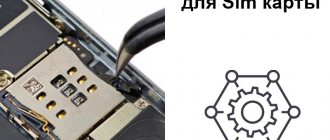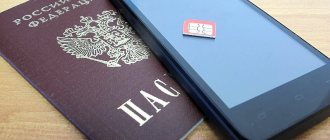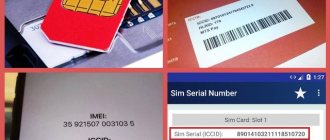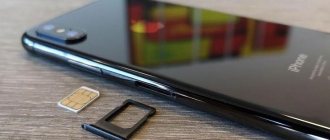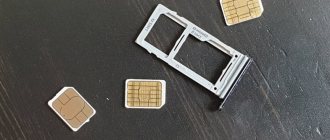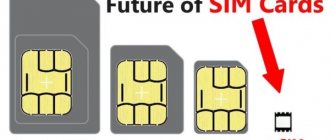Experienced communication store consultants still remember the time when customers were perplexed by the fact that there were SIMs of non-standard sizes. Nowadays, having several types of SIM cards is commonplace. Manufacturers are giving preference to increasingly smaller cards, because this saves space inside the device body. Standard-sized SIM cards, bulky by modern standards, are about to “sink into oblivion.”
In this article we will talk about all types of SIM and teach you how to turn a large card into a small one.
What are the sizes of SIM cards?
In terms of size, SIM cards are classified into 3 types:
Mini-SIM
Mini-SIM is the scientific name for a standard SIM card. Its dimensions are 25x15 millimeters.
If the phone was released before 2011 (inclusive), you can be sure that it is the Mini-SIM . For modern smartphones, such a card is too large, but this does not mean that Mini-SIM is an anachronism. Standard SIM cards are used in simple dialers, in phones with large buttons for the elderly, in secure phones for fishing enthusiasts and factory workers. The listed devices cannot boast of an abundance of functions, so there is plenty of space inside their cases - in some models, manufacturers even allow you to install 3-4 Mini-SIM .
Micro-SIM
Apple was the first to use Micro-SIM cards Micro-SIM are 15x12 millimeters.
Nowadays, the vast majority of smartphones are equipped with Micro-SIM . Nokia took over the baton from Apple, equipping its Lumia devices with slots for Micro , followed by HTC, Samsung, and BlackBerry.
Nano-SIM
Nano-SIM is the newest and smallest phone card. Its dimensions are only 12x5 millimeters. Visually, the card is a chip with a minimum of plastic edging.
Apple is again the innovator. It was the Nano-SIM that users had to insert into the iPhone 5th modification. Later, other well-known manufacturers began to produce devices with Nano-SIM slots - for example, Samsung and Meizu .
The following illustration will help you understand the differences between the three types of SIM cards:
What is eSIM
This is a chip (embedded SIM - built-in SIM) that is installed inside a smartphone or other device. You can record the same information on it as on a regular SIM card.
To connect an eSIM to the operator’s network, you need to receive a set of encrypted data from it and save it.
eSIM saves space inside the smartphone. The chip can be installed anywhere, and since you don’t need to take it out, there won’t be a hole for a “clip” in the case. Protection from dust and moisture is easier to organize.
In addition, to change the operator, you do not need . You can even connect to several operators - save different profiles with your own settings.
People started talking about eSIM when Apple released the iPhone XS/XR/XS Max. Previously, built-in SIM cards were used in the 2021 Samsung Gear S2 3G smartwatch and Apple Watch 3/4. Received eSIM support and Google Pixel 2 smartphone.
The problem is that not all operators support the technology. And in some countries (including the Russian Federation) eSIM is generally illegal .
Firstly, writing data to an eSIM is equivalent to copying a SIM card. This is a fraud.
Secondly, with eSIM you can switch to a new operator without notifying your previous one. This is a violation of the terms of the contract.
In general, for now eSIM can only be used in certain countries. And not all operators.
Read in our other article all the details about eSIM, as well as about the differences between eSIM and a regular SIM card.
How to change the SIM card size for your phone?
The most obvious way to change the size of a SIM card is to replace it at the operator's salon . This procedure is completely free, takes only a couple of minutes, and the phone number does not change subsequently. However, this method still has a number of disadvantages:
- The new SIM card will not contain the numbers stored in the memory of the old one. Of course, such a problem is easy to solve : in the article “How to transfer contacts from iPhone to computer” we talk about several ways to export phone numbers. But, alas, many users consider their time too valuable to waste it on mastering third-party software and methods for creating backup copies.
- Only its issuer has the right to replace a SIM card in the office . If the card was given to the user, for example, by his parents, he himself will not be able to replace it. Sometimes this becomes a real problem.
If a consultant changes a SIM card to a person who is not its issuer, this is fraud! For such an operation, the consultant will, at a minimum, be deprived of his bonus, and at maximum, he will be fired in disgrace. Therefore, demanding to “make an exception” is meaningless; no one wants to find themselves unemployed with unflattering wording in their work book.
There are several ways to change the dimensions of a SIM card without resorting to replacement. For example, the user can purchase an adapter (aka adapter ). The adapters look like this:
It’s better to order adapters for SIM on Chinese websites - there they cost a mere trifle. For example, a set of adapters from Noosy along with a needle for iPhone will cost only 17 rubles. When purchasing in a salon, the user may be charged up to 250 rubles - the difference is more than noticeable!
The set, as a rule, includes adapters of 3 types: Nano-SIM to SIM , Micro-SIM to SIM and Nano-SIM to Micro-SIM . Since SIM cards of reduced sizes continue to be associated with Apple, manufacturers do not forget to include needles in the kits to remove the SIM card slot. Using adapters is simple : a small SIM card is inserted into a suitable adapter, then the adapter itself with the card inside is placed in the slot of the mobile device.
Adapters help when you need to increase the size of a SIM card, but what should the user do if, on the contrary, the card needs to be reduced? The owner of the gadget should think about the fact that such a need may arise even at the stage of purchasing a SIM card - and insist on issuing him a so-called Combi-SIM . Combi-SIM is a standard-sized card that can be converted into a micro-SIM in a split second.
Inside the SIM card, which is standard in size, the Micro-Sim is already cut along the contour, so it is easy for the user to press with a finger and break off a piece of plastic.
There is no need to rush to throw away the frame - it can still serve a good purpose. If you need to reinsert the card into the Mini-SIM slot, the frame can be used as an adapter.
Using Combi-SIM is one way to change the size of a SIM card downwards. Combi cards are provided to mobile users free of charge - of course, if they are available at the operator's office.
If the user already owns a standard SIM card and wants to turn it into Micro without losing contacts, he has no other choice but to cut the SIM card. Trimming, as a rule, is carried out using a special device called a stapler for Sim (also known as cutter for Sim , also known as Sim-Cutter ).
Making a Micro-SIM with such a stapler is a second procedure. However, you should not expect that a sales office or workshop will carry out this procedure for free . The salon employees will demand 149 rubles for trimming and will even knock out a check for providing a paid service. Repair shops will also ask for money, or even send the user to deal with the operator.
Cutting a SIM card is associated with some risk - if the person performing the procedure is in a hurry or is inattentive, he will damage the chip and, as a result, the SIM card will not function. Hence the high cost of pruning services - no one wants to take risks “for nothing.”
conclusions
Progress does not stand still; constant evolution occurs even in those aspects of technology that are not very noticeable. It would seem that reducing the size of SIM cards does not greatly affect our ease of using a smartphone. However, this seemingly insignificant improvement allows developers to save space inside the phone body, which means offering us more advanced cameras, faster fingerprint scanners, and so on.
Nano SIM is the smallest card possible today, but it is not the pinnacle of technological progress. If rumors are to be believed, by 2021 major smartphone manufacturers may abandon physical cards altogether and completely switch to electronic eSIMs. We will still see whether this option will be better than the traditional one, but the fact that it will be much more convenient for new buyers is obvious now.
How to cut a SIM card with your own hands?
Not all cellular communication stores have SIM staplers - some consultants continue to cut cards with their own hands and with ordinary scissors. The reader may be surprised to learn that no one trains consultants to do this. They hone this skill on their own, and many are able to successfully cut a SIM card the first time .
No wonder - in fact, the procedure is extremely primitive! Usually the main difficulty is finding a pattern. Consultants, as a rule, have their entire table littered with SIM cards of various sizes that work and have served their useful life - they use them as samples. The average user can only dream of such abundance - however, if he still managed to borrow a SIM card of the required size to serve as a template, he can safely try trimming it himself. If not, he should resort to using a printer and print out (here is a suitable link).
To cut a SIM card, you don’t need felt-tip pens, rulers or pencils - if you follow these instructions:
- Take the large SIM in your hand with the chip facing up.
- Place the sample card on top so that it completely covers the chip, press it tightly with your thumb and do not let go. If desired, the template can be attached to a large SIM using double-sided tape, but experts do not recommend doing this - you can damage the chip.
- Carefully trim the sides of the plastic. Try not to have too much, otherwise the SIM card in the slot will “dangle” and the signal will be lost.
- Cut the card crosswise according to the template . Here you can act less scrupulously; The main thing is not to touch the chip.
- Remove the corner and slightly round the edges - otherwise the SIM card will not fit into the slot.
Next, put the template aside and try to install the cut card into the phone to check its functionality. If the SIM card does not fit into the slot, carefully trim the plastic and try again. If the card slot is just the right size and can be read by the phone, rejoice - you just cut a SIM card with your own hands!
Please note that not every map can be “cut” to the desired size. The easiest way is to convert a Mini-SIM into a Micro-SIM - such cutting should not cause any difficulties for the user at all. Cropping for Nano-SIM is always more difficult; plastic around the chip on the Nano , so the risk of snagging the chip with the blades of scissors is quite high.
Old-style SIM cards with large chips are still in use:
Cutting such SIMs is a real nightmare! With some luck, you can make a Micro-SIM , but you definitely won’t be able to turn it into a Nano .
How do criminals steal data from a SIM card?
To obtain data from a card, SIM scanners or SIM cloners . You can buy them for 150 rubles or even cheaper.
More or less legal scanners do not read KI, so as not to allow scammers to clone a SIM card and use it to hack accounts. In fact, the SIM card processor works directly with KI, and there is no need to transmit the identifier to the external network .
KI is stored in a read-protected memory area. But if you repeatedly run the A3 algorithm on the scanner and enter a random RAND password, then cryptographic methods for analyzing the SRES response will allow you to calculate KI. It takes less than a minute .
However, SIM cards have a kind of self-destruct timer . After a certain number of runs of the A3 algorithm, the SIM card processor stops calculating SRES and generally responding to requests.
But crypto methods only work effectively with older versions of the A3 algorithm - COMP128v1. Operators use it extremely rarely. COMP128v2 and COMP128v3 simply will not allow you to calculate RAND-SRES and KI. At least quickly and for sure.
So if you want to buy a scanner that hacks everything, or download a program that will pull out KI from any card, most likely you will be scammed . And they will also give you a Trojan to get your data.
The problem is that the fraudster has access to the operator's database and can obtain a set of keys for a large number of SIM cards. If hackers have at their disposal a table of correspondence between SIM cards and KI, which the manufacturer transfers to the operator with the next batch, the data will also be at risk.
But this is rather a theoretical possibility. As well as the transfer of keys over the air of a mobile operator. KI is not broadcast, so it is impossible to intercept it directly.
Is it true that a SIM card can become demagnetized?
No . Although operators love this fairy tale.
A SIM card is a miniature computer, a printed circuit board with contacts. It has a processor, RAM and permanent memory, and auxiliary elements.
But there is nothing . You can’t demagnetize the processor in a computer or smartphone, right? Try it, of course, what if...
But the SIM card can be damaged. For example, if it is bent or wet and not properly dried.
Theoretically, the card could fail due to static voltage. If you rub it on a synthetic suit, for example. But why?
Finally, any memory chip has a resource of rewrite cycles. At a certain point, memory cells will simply stop changing state.
But all this has nothing to do with demagnetization. Not at all .

